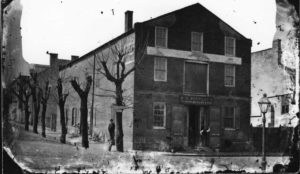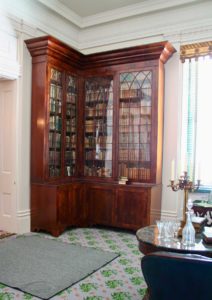Work and Wealth in the Antebellum Natchez Furniture Trade
EMERGING SCHOLARS > SUMMER RESEARCH GRANTS
Candice Roland Candeto,
MA Candidate, Winterthur Program in American Material Culture, University of Delaware
The life and work of antebellum cabinetmaker Robert Stewart (1796–1866) spanned one of the most contentious periods in American history in Natchez, MS, one of the country’s most complex cities. A Mississippi River port of great diversity and incredible wealth, Natchez was a social center where large, fashionable homes communicated the success of planters whose riches grew in sugarcane and cotton fields. Stewart played a significant role in shaping the community by furnishing the homes of all levels of Natchez society. Selling both imported and locally made pieces, he created a unique material culture that speaks to the town’s distinct identity—dependent upon the river and slavery—and illustrates its strong connections to the Northeast and broader Atlantic world.
Hailing from Chester County, PA, Stewart and his brother Miller operated R. & M. Stewart at two locations in the 1820s, with a furniture manufactory in Cincinnati that shipped pieces downriver to Natchez for sale. Recent work by the Classical Institute of the South and Mimi Miller of the Historic Natchez Foundation has brought surviving Stewart furniture to light. A chest of drawers featuring elaborately carved columns with scrolled capitals bears the inscription “R. & M. Stewart/Natchez,” dating it to between 1826 and 1835 when the Stewarts were operating in both cities. This chest speaks to the fashionable nature of the goods coming out of the Stewart manufactory and to the high quality of furniture the southern and western markets were demanding in this period. Although Robert closed the Cincinnati branch in 1835, four years after his brother’s death, he continued to retail furniture from famous the city’s respected craftsmen, such as Mitchell & Rammelsberg, to Natchez customers.
Throughout the Antebellum period Stewart’s business grew alongside his city. Though he sold furniture across many socioeconomic levels, wealthy cotton planters were among Stewart’s most prominent customers. John T. McMurran represents a case study of how these ultra-wealthy clients used Stewart’s shop to create their domestic statements of power and success. Stewart provided services for McMurran’s home, Melrose, that ranged from the construction of magnificent walnut bookcases in the library to simply unboxing a set of Philadelphia-made Gothic Revival chairs purchased for the dining room. (N.B. Trust members who participated in the 2014 symposium in Natchez will recall visiting Melrose, a National Park Service site.)
Stewart’s account books at Louisiana State University document the bustling activity of his shop and the many hands that kept it running. Journeymen created everything from chairs to secretary desks, demonstrating an active furniture trade at a time when many once believed little of note was produced in Mississippi. Dozens of other men, women, and children contributed as well, including apprentices, white female upholsterers, Stewart’s sons, and Dick, an enslaved craftsman whose labor Stewart rented for years. Stewart’s remarkably well-documented life and business sheds light on the changing nature of the cabinetmaking profession in the nineteenth century, and compels us to consider the many hands that took this furniture from workbench to customer’s home.
I am grateful for the Trust’s support of my research, which is shedding light on one of the Gulf South’s most important and well-documented Antebellum craftsmen.



